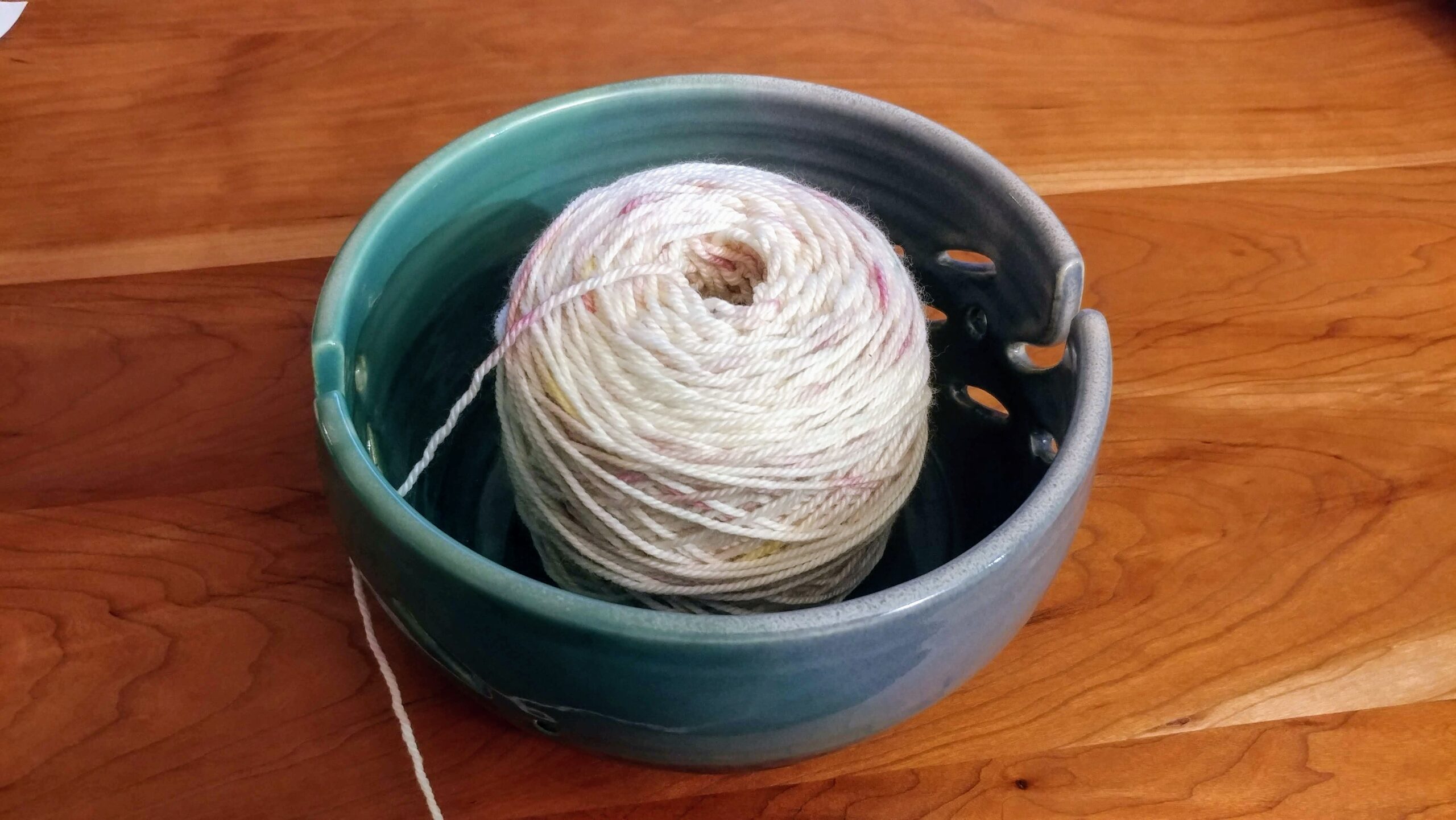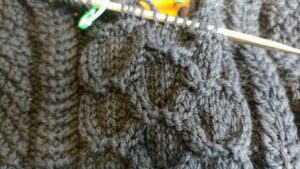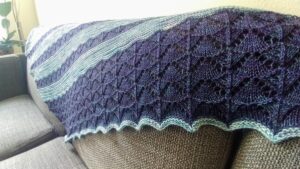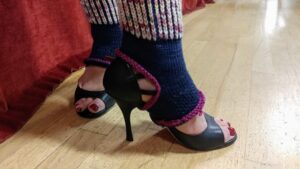Have you ever dived into a knitting pattern and then gotten stuck on the project? Or worse, it didn’t turn out the way you wanted it to? It might not have been your fault, just a poorly written knitting pattern! I’m going to show you how to read a knitting pattern so the next time you start a project, you’ll be confidant to have a great result at the end!
For this exercise, I’m going to walk through a few different free patterns. These are by companies or designers I respect and trust. Feel free to download these or follow along with your own pattern! The reason why I selected several different designs is because there are many aspects of published knitting patterns which are somewhat standardized, and it’s helpful to see how those concepts are exhibited in different ways. The patterns I chose are Felicia Lo’s Five by Five Cowl, Jared Flood’s Turn A Square Hat, and Stephanie Pearl McPhee’s Daisy Sweater.
Name & Description
Right away you should be able to find the name and a brief description of the pattern. What’s this thing called and what the heck is it? Many designs in the hand knitting world are referenced by the design’s name. I also try to reference the design name in most of my projects. This helps when you see something you like and gives you some information of how to look it up later. Hopefully this far in you have a good idea of what to expect. It would be terrible to think you are making a scarf and ended up with a sweater by the end!
If you are following along, this is what you would find for the referenced patterns:
- Five by Five Cowl – A Ribbed Infinity Cowl
- Turn A Square – Everyday Striped Beanie
- Daisy – A Simple Cotton Baby Cardigan with Variations
Difficulty
You should also be able to easily find the pattern difficulty. This can help you gauge if it’s a pattern that will challenge you or if it will be a good project for more social knitting. I try to only have one or two projects in progress, but I know many knitters who have projects for every situation. If you’re just getting started out with knitting, it can be helpful to know if a project is designed for someone at your level, rather than get frustrated trying to make something you’re not ready for yet.
For the referenced patterns:
- Five by Five Cowl – Beginner
- Turn a Square – Beginner
- Daisy – Tangy. This uses Knitty’s gauge of difficulty levels, which you can find here. According to them, “Tangy” means “Fun things with a zing. A twist, even.” and “Friendly + unintimidating: very knittable by most knitters.” This might not be great for a first project, but it sounds like this might be a great first sweater!
Finished Measurements/Sizing
Finished measurements and sizing information will give you an idea of how big an item will turn out. In the case of sweaters it should list the different sizes that are available for the design. I use these to give me a general idea of what to expect when I’m finished. Sweaters usually list general fit information, which can be helpful if I am between sizes and trying to figure out which size is better for me.
For the referenced patterns:
- Five by Five Cowl – 52″ around, 7″ wide. This is a substantial cowl, but if you like longer infinity cowls this is a good clue that you’ll want to knit a longer one.
- Turn a Square – One Size Fits Most. There are also some general sizing guidelines. If your intended wearer has a significantly smaller or larger head than this, you’ll know to either adjust the pattern or pick another one. There is also a diagram for how long the different parts of the hat are and the knitting direction.
- Daisy – This sweater has sizes, and measurements for the width, length, and arm length for each size. Great information if you need to make adjustments!
Yarn Used
The listed yarn was used for the samples, and the intended yarn for the design. If you’re not able to get the yarn used (maybe it’s discontinued, or maybe it’s just too expensive!), you can use the yarn content and weight information to find a reasonable substitute. I try to match the general content of the yarn as well as the weight-to-yardage ratio when I make yarn substitutions. If you really like the colors used in the sample, these will be listed as well in case you want to make your own!
For the referenced patterns:
- Five by Five Cowl – A laceweight mohair-silk blend and two fingering yarns are held together to create a marled effect. On her blog Felicia makes some suggestions depending on what kind of fabric you’d like the cowl to have.
- Turn a Square – One skein each of worsted weight wool in two different colors are used. There is also an approximation of how much yarn is used, which is helpful if you wanted to try making this with leftover yarn from another project.
- Daisy – A DK weight cotton yarn is used, along with number of skeins per size. I’m not familiar with this yarn, but can look it up on Ravelry and see that it’s still available.
Needles/Notions/Tools Required
Sometimes you’ll see this as one section, and sometimes you’ll see the needles separated out from the notions. It’s good to have a general knitting notions bag with commonly used tools, but this section will also let you know if you might need something a little specialized, like a small crochet needle for applying beads. If something specialized is required, there may be an easy substitute I can make based on what I have, or I may need to go shopping.
I take most of the needle sizes as suggestions – I knit loosely and typically have to go down at least one and sometimes two needle sizes. The actual needles I use will depend on a couple factors, but look at the pattern for guidance.
For the referenced patterns:
- Five by Five Cowl – Large (10 3/4) needles here! I should have expected that given it’s intended to hold three yarns together. A crochet hook and waste yarn are also required for the provisional cast on technique used.
- Turn a Square – 16″ circular needles are a common size for hats, and at least one stitch marker for marking the beginning of the round. This is a standard set of tools for making a hat. You can use double pointed needles as suggested or the magic loop technique to finish the crown of the hat.
- Daisy – Buttons and stitch holders seem to be the special things required for this pattern. If you don’t have stitch holders you can use waste yarn to hold the live stitches on. Usually button sizes are listed but they are not in this pattern, so you might have to wait until you finish this project before you get the buttons if you’re not familiar with how large the buttonholes will turn out.
Gauge
How many stitches and rows per inch, typically over four inches. Usually gauges are in stockinette but might also be in a pattern used in the design. This will give you an idea of what the resulting fabric is intended to be like. I usually make a gauge swatch for sweaters and size-dependent things, and I use the needle size that will get me closest to the gauge. For things like shawls I usually pick a needle I’ve used before for that weight yarn.
For the referenced patterns:
- Five by Five Cowl – 14 stitches x 18 rows over 4 inches in stitch pattern. This seems reasonable given the needle size used.
- Turn a Square – 5 stitches per inch in stockinette. This is a typical gauge for worsted weight yarn.
- Daisy – 20 stitches/28 rows over 4 inches in stockinette. This seems a little loose for DK weight yarn, however, I’m not familiar with knitting in cotton and would want to make sure I like the resulting fabric.
Abbreviations
I’ll usually glance over the abbreviations to make sure I understand all of them. Sometimes the designer will want to use a specific technique for m1/d1, or use a specific abbreviation for a stitch I might not be familiar with. When I don’t understand an instruction in a pattern I’ll go back to the abbreviations to review what I might have missed.
For the referenced patterns:
- Five by Five Cowl – All these abbreviations seem standard to me.
- Turn a Square – Specific techniques are used for M1 and SSK and are described in the instructions.
- Daisy – There is no specific abbreviation list here, but Knitty does have standard abbreviations listed on the same page as the difficulty levels.
Special Techniques/Pattern Charts
If there are special techniques used, they will be at best described in this section and at worst listed or referenced here. For techniques you may be unfamiliar with, it’s helpful to have a good knitting reference. Vogue Knitting is the general reference I use. You can always rely on Google or YouTube to find clear directions and visual reference. I would also expect to find written descriptions and/or charts for any special stitch patterns used. I like using projects to learn new techniques, and sometimes will choose projects based on what I might learn from them.
For the referenced patterns:
- Five by Five Cowl – The five by five ribbing pattern is written out, and the directions for Kitchener stitch in ribbing is described under Special Techniques. Provisional cast-on is not described under special techniques but is used in the pattern. If you’re unfamiliar with it you’ll need to look it up.
- Turn a Square – Working jogless stripes is a technique described here, which might make this a good pattern to practice this on if you’re that style of knitter. There are also some web references for finishing and knitware care instructions.
- Daisy – I don’t see any special techniques or pattern charts listed in this pattern.
Pattern Instructions
Finally we get to how to make the thing! I’ll read through the instructions to see if they make general sense to me. If I’m making a specific size I will circle stitch counts for my size and cross out sections that don’t apply. This helps me prevent making mistakes later. I will also mark or make a note if something seems weird or strange to me. If I want to make a design alteration or use a different size for a specific section I’ll make a note at that place in the pattern as well.
Finishing
Finishing instructions will include how to finish the completed item. For things like sweaters there should be blocking diagrams for the size and shape of the design. None of these patterns have blocking diagrams, however the Daisy pattern has different finishing instructions for each variation.
Designer & Contact Information
You’ll usually find some information about the designer, and contact information for pattern support in case you run into trouble. Designers want you to be successful in making their patterns! If you get into trouble it’s OK to reach out to them! In newer patterns you might also find some tags you can use on social media so the designer or others can easily find your work.
I hope you know how to read a knitting pattern now! You can always find my tutorials on the Tutorials Page. Are there any tips or techniques you use when reading knitting patterns?



